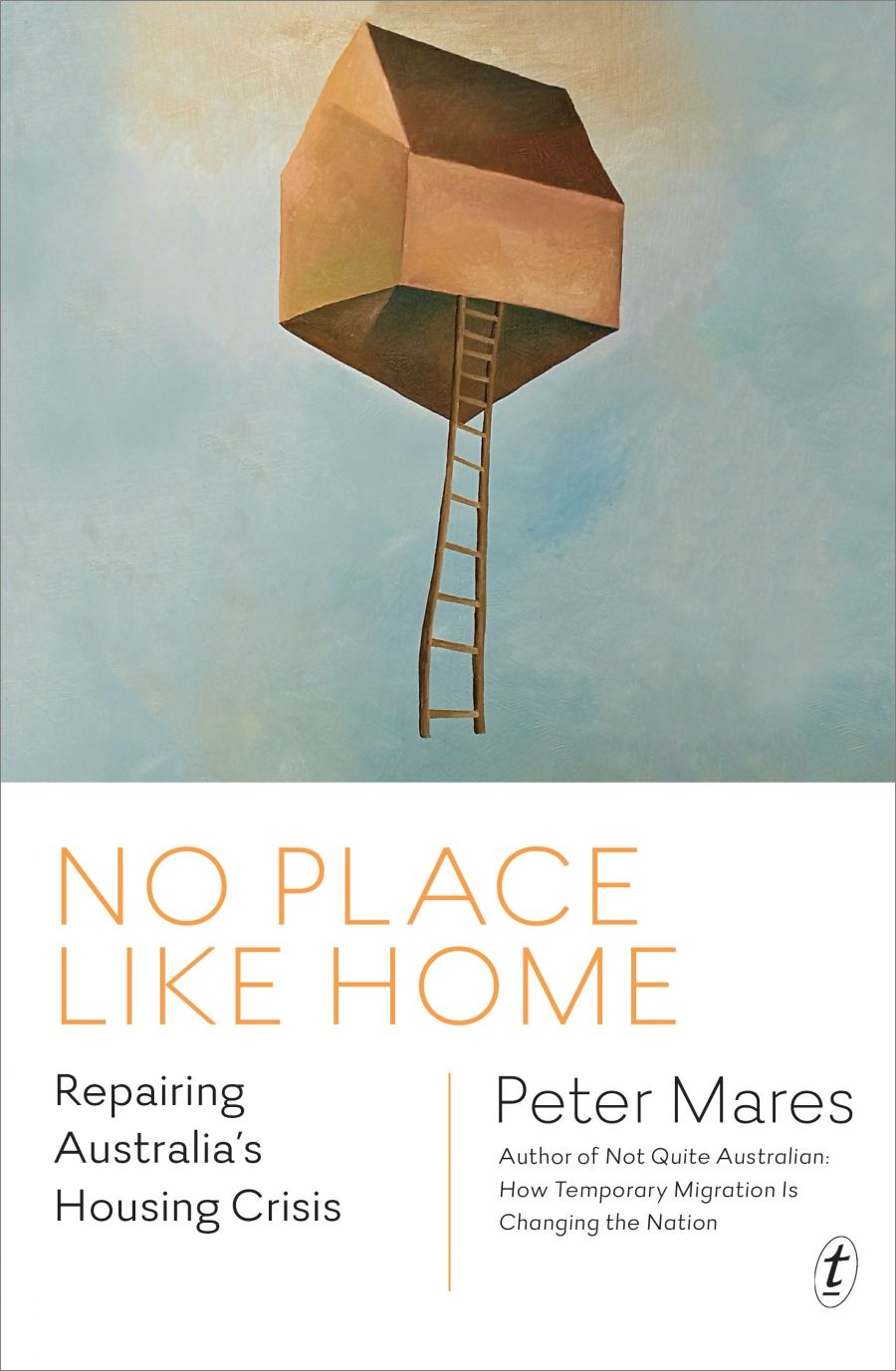
- Free Article: No
- Contents Category: Commentary
- Custom Article Title: Tom Bamforth reviews <em>No Place Like Home: Repairing Australia’s housing crisis</em> by Peter Mares
- Custom Highlight Text:
In his analysis of Australia’s growing urban inequality, Peter Mares recounts a conversation with a homeless man outside a train station while Mares was walking his dog. The dog is well fed and has a warm place to sleep, but Mares can only give the man a few coins. These are implicit priorities we all share. Why, asks Mares, do Australians unhesitatingly spend $750 million annually on ...
- Book 1 Title: No Place Like Home: Repairing Australia’s housing crisis
- Book 1 Biblio: Text Publishing, $32.99 pb, 318 pp, 9781925603873
In his book The Forgotten People (1943), Robert Menzies articulated a vision of homeownership that has remained central to the Australian dream. ‘One of the best instincts in us,’ he wrote in 1944, ‘is that which induces us to have one little piece of earth with a house and a garden which is ours.’ The wider experience of housing stress means that Menzies’ ‘forgotten people’ – the ‘salary earners, shopkeepers, skilled artisans, professional men and women, farmers, and so on’ – can now no longer afford to rent, much less to own, their ‘little piece of land’. Rates of home ownership in Australia have continued to fall. When Menzies stepped down in 1966, home ownership was seventy-one percent but had fallen to an all time low of 65.4% in the 2016 census, decreasing sharply from 68.1% in the decade since 2006. Yet home ownership is core to Australia’s political DNA.
Whether the crisis is caused by immigration, urban population growth, shortage of housing stock, planning regulations, zoning laws, low urban density, negative gearing, low wages growth, lack of rental protection, miserly social welfare provisions, wealthy overseas investors, a tax regime that exempts the ‘family home’, or over-investment by the young in smashed avocado (according to Bernard Salt in The Australian) depends on your ideological predisposition. John Howard famously observed: ‘I don’t get people stopping me in the street and saying, “John you’re outrageous, under your government the value of my house has increased”.’ For former Treasurer Joe Hockey, buying a house was a question of ‘getting a good job that pays good money’, advice he has taken for himself at considerable public expense. For Malcolm Turnbull, as for Victorian Premier Daniel Andrews, the real problem lies with a lack of new dwellings. What is clear, however, is that policy settings and political culture are a long way behind ensuring adequate housing for all. ‘Politics,’ as Liberal politician and housing advocate John Alexander observes, ‘stuffs things up.’
While Mares delves into these debates and casts light on their often-complex interactions, his starting point is the housing experience of the people he knows. Encounters with renters, owners, investors, policy-makers, real estate agents, social workers, and housing advocates recur throughout the book and make the intricacies of housing policy compellingly humane. Underpinning Mares’s investigation is a comparative experience with his former flatmate Carolyn. They were renting together in the early 1980s when Carolyn prophesied, with broad accuracy, that Mares would become a ‘Volvo-driving academic’. Mares duly became a homeowner and entered the ranks of middle-class solidity, and he will eventually pass on his assets to his children. They will receive their share of around $407 billion in intergenerational wealth transfer from baby boomers by 2025. In contrast, Carolyn, a single mother of two, continued renting. She lives in housing stress and faces an uncertain future, enduring the humiliating tactics of estate agents, for whom renters often are second-class citizens. ‘Housing stress’ is broadly defined as paying more than thirty per cent of household income on rent. Had Carolyn been on government benefits, this figure would have risen to between sixty and one hundred per cent of income spent on rent. The Productivity Commission estimates that fifty-three per cent of low-income households live in rental stress. Why?
In Australia’s ‘Game of Homes’, housing is a financial product, not a place of one’s own. The primary residence is exempt from any form of capital gains, wealth, or inheritance tax, and has almost no impact on pension entitlements. Mares estimates that these tax concessions could be worth $100 billion per year. Australia’s housing boom, based on equity from the private home, ensures that property developers build investor assets, rather than affordable houses. In the indiscriminate depositing of city apartment blocks (‘birdshit architecture’, according to urban theorist Jan Gehl) and in developments such as Fisherman’s Bend in Victoria, developers build for the affluent, who seek a spot on the ‘housing escalator’ to wealth. While city centres grow taller and suburbs on the urban periphery expand, there is a problem of the ‘missing middle’. Despite the fact that the older leafy charm of areas such as Melbourne’s inner-east is being replaced by ‘Tuscan’ McMansions, local residents have often opposed greater density, fearing that it will lower prices and alter local character.
If Australia is to build the estimated 200,000 affordable dwellings required to relieve current housing pressure, a more sophisticated approach is needed. Mares offers a palette of well-considered policy options. He questions the excessive protections on the private home and advocates the capital gains tax, the abolition of negative gearing, and the introduction of a broad-based property tax (as has been adopted in the ACT) in place of stamp duty, as well as protecting long-term rentals as a viable form of tenure, as is done in Europe. The development of mixed-occupancy community (as opposed to social) housing, increased funding in rental assistance programs for low-income earners, and the promotion of long-term, build-to-rent developments would ensure more affordable and accessible housing stock.
No Place Like Home is a superb dissection of Australia’s housing crisis. Sadly, Mares’s modest reforms will be far too bold for either of the main political parties in upcoming elections.


Comments powered by CComment